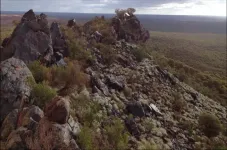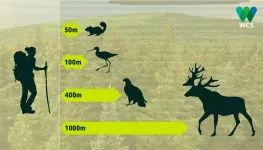(Press-News.org) Up to three quarters of the biodiversity living on Western Australia's iconic ironstone mountains in the State's Mid West (known as Banded Iron Formations) could be difficult or impossible to return quickly to its previous state after the landscape has been mined, a Curtin University study has found.
The research published in Ecology and Evolution, discovered that the plant ecosystems are well-adapted to the characteristics of the region's ancient and nutrient-poor soils - and that the very different features of mined landscapes mean many native species are unlikely to be returned by rehabilitation.
Lead researcher Dr Adam Cross from Curtin's School of Molecular and Life Sciences said the elevation and different habitats offered by Banded Iron Formations (BIF) in an otherwise dry, mostly flat landscape, make them a sponge for biodiversity - but that their iron-rich rock made them increasingly attractive to iron-ore miners.
"Unfortunately, the chemical characteristics of some tailings and other by-products produced by mines can be more similar to material on the moon than to the ancient, highly-weathered soils of BIF, and this presents a really challenging, hostile environment for many native plant species," Dr Cross said.
The Mid West region is known for its BIF ranges, which Dr Cross describes as stunning natural 'museums', that host much of the regional florist biodiversity. He said almost every plant species from the surrounding landscape can be found on them - as well as some unique species found nowhere else.
"These collections of species have accumulated over very long periods of time, and the increased pressure to mine BIF is putting the biodiversity at risk. Once BIF are gone, that's it - we cannot recreate these iconic landforms, and our study suggests that, even if we could, the post-mining environment likely wouldn't support many of the species that used to call them home."
"BIF harbour such biodiversity because in periods where the climate has been hotter and drier, their rocky, complex soils offered a cooler, wetter refuge for many species that were unable to survive in the surrounding landscape.
"With climate change suggesting a hotter, drier outlook for the Mid West region in future decades, it is increasingly important that we preserve and conserve remaining BIF habitats and the species growing on them."
The research team looked at 538 plant species in an 82,000 hectare area in WA's Mid West, assessing their growth on different soil types across the region and examining their potential tolerance to the chemical characteristics of mined materials.
Although many species were adapted to the acidic, nutrient-poor soils of BIF, the team found at least some were tolerant of a wide range of soil types and might be used as 'pioneers' to help kick-start vegetation recovery in rehabilitation.
Dr Cross said more studies were needed to find ways to rapidly change the chemical characteristics of post-mining soils to speed up rehabilitation, and preserve the area's biodiversity.
"The mining industry needs to consider the soil properties of landforms requiring rehabilitation or ecological restoration, and the implications for vegetation establishment and plant community development, at the very earliest stages of planning or environmental impact assessment," Dr Cross said.
"Ecosystems are extremely complex; we need to recognise, appreciate and learn from this complexity when we are attempting to return biodiversity to areas that have been impacted by mining.
"We need to reach a happy medium between development and conservation to effectively continue mining in these areas, while preserving our incredible natural resources."
INFORMATION:
The research was funded by The Centre for Mine Site Restoration at Curtin University.
The full paper Calcicole-calcifuge plant strategies limit restoration potential in a regional semi-arid
Flora can be found online here: https://onlinelibrary.wiley.com/doi/10.1002/ece3.7544.
One person in 2000 suffers from a microdeletion of chromosome 22 that can lead to the development of psychotic disorders, such as schizophrenia, in adolescence. In addition to symptoms such as hallucinations or delusions, psychotic disorders also comes with a progressive decline in intelligence quotient (IQ). If current drug treatments are successful in containing psychotic symptoms, nothing can be done to prevent the deterioration of intellectual skills that leads to loss of autonomy. Researchers at the University of Geneva (UNIGE), Switzerland, have discovered that prescription of selective serotonin reuptake inhibitors (SSRIs) - a class of drugs used to treat anxiety and depression -in late childhood can reduce the deterioration ...
ALS is a very severe neurodegenerative disease in which nerve cells in the spinal cord controlling muscles and movement slowly die. There is no effective treatment and the average life expectancy after being diagnosed with ALS is usually short. Because of this, new knowledge about the disease is urgently needed.
Now, researchers from the University of Copenhagen have gained new insights about ALS, by investigating the early development of the disease in a mouse model.
"We have found that networks of nerve cells in the spinal cord called inhibitory interneurons lose connection to motor neurons, the nerve ...
Researchers have created a new nanometer-scale proximity labeling system that targets histidine residues quickly, providing a new chemical tool in protein chemical modification.
The results of their research were published in the Journal of the American Chemical Society on April 27, 2021.
Protein chemical modification, a technology that introduces functions into the chemical structure of proteins through irreversible strong bonds, is used for the creation of protein-based biomaterials and for drug delivery systems.
In order to carry out modification, protein labeling is necessary. Proximity labeling is one of those techniques. It labels biomolecules located close to a protein of interest which can then also be marked ...
The photochemistry of the future will spring up human industry without smoke, and bring a brighter civilization based on the utilization of solar energy instead of fossil energy. Photochemistry has been used in controlling many reaction processes, especially for the challenging reactions containing selective C-H activation and C-C coupling in chemical synthesis. It is of great interests that a "dream catalytic reaction" of direct coupling of methanol to ethylene glycol (2CH3OH ? HOCH2CH2OH + H2, denoted as MTEG) could be achieved through the solar energy-driven C-H activation and C-C coupling processes, and this MTEG reaction has not been achieved through thermocatalysis yet.
Ethylene glycol (EG) is an important monomer for the manufacture of polymers (e.g., poly(ethylene ...
Spending time outdoors is good for a person's body and soul, but how good is it for the wildlife around us?
Outdoor recreation has become a popular activity, especially in the midst of a pandemic, where access to indoor activities might be limited. Long known to have negative behavioural and physiological effects on wildlife, outdoor recreation is one of the biggest threats to protected areas. Human disturbance to animal habitats can lower their survival and reproduction rates, and ultimately shrink populations or eradicate them from areas where they would ...
Researchers have identified the key factors that influence a vital pattern of ocean currents.
The Atlantic meridional overturning circulation (AMOC) carries warm water from the tropics northward.
Many scientists think that this heat transport makes areas including north-west Europe and the UK warmer than they would otherwise be.
Climate models suggest the AMOC is likely to weaken over the coming decades, with widespread implications for regional and global climate.
The new study - led by the universities of Exeter and Oxford, and published in Nature Geoscience - pinpoints the causes of monthly and annual AMOC variation and finds a differing picture at two key locations.
Observational data came from large ...
The Covid-19 pandemic has introduced us to expressions like 'lockdown', 'isolation' and 'social distancing', which became part of social conduct all over the world. Now it appears that bats also maintain social distancing which might help prevent the spread of contagious diseases in their colonies. In a new study published in Annals of the New York Academy of Science, researchers from Tel Aviv University demonstrate that sick bats, just like ill humans, prefer to stay away from their communities, probably as a means for recovery, and possibly also as a measure for protecting others. The study was conducted by postdoctoral researcher Dr. Kelsey Moreno and PhD candidate Maya Weinberg ...
Methane emissions from North American livestock may be routinely undercounted, a new analysis by researchers at New York University and Johns Hopkins University finds. The work also notes that in developing countries, where animal agriculture is becoming increasingly industrialized, methane emissions could rise more than expected.
These assessments are based on a review, appearing in the journal Environmental Research Letters, of eight existing studies.
Methane is a global warming gas even more powerful than CO2. Its amount and lifetime in the atmosphere are smaller than CO2, but quantities are still increasing. The United Nations has recently ...
RNA sequencing is a powerful technology for studying cells and diseases. In particular, single-cell RNA sequencing helps uncover the heterogeneity and diversity of our body. This is the central technology of the "Human Cell Atlas" in its quest to map all human cells. However, single-cell RNA sequencing reaches its limits in very large projects, as it is time-consuming and very expensive. To address these challenges, scientists from the research group of Christoph Bock, principal investigator at the CeMM Research Center for Molecular Medicine of the Austrian Academy of Sciences and professor at the Medical University of Vienna, developed ...
Researchers at the Biomedicine Institute of Seville (IBiS) have discovered a new mechanism of Alzheimer's disease that disorganises the blood vessels around amyloid plaques, one of the characteristic features of the disease. The study, published in the international journal Nature Communications, was led by the laboratory of Dr. Alberto Pascual, from the Neuronal Maintenance Mechanisms Group at IBiS and was chiefly carried out by María Isabel Álvarez Vergara and Alicia E. Rosales-Nieves.
Relevance of the finding
Alzheimer's disease is the leading cause of dementia worldwide. In Spain, its incidence is increasing dramatically as the population ages and yet, unfortunately, the origin of the disease is still unknown.
The mechanism put forward ...








